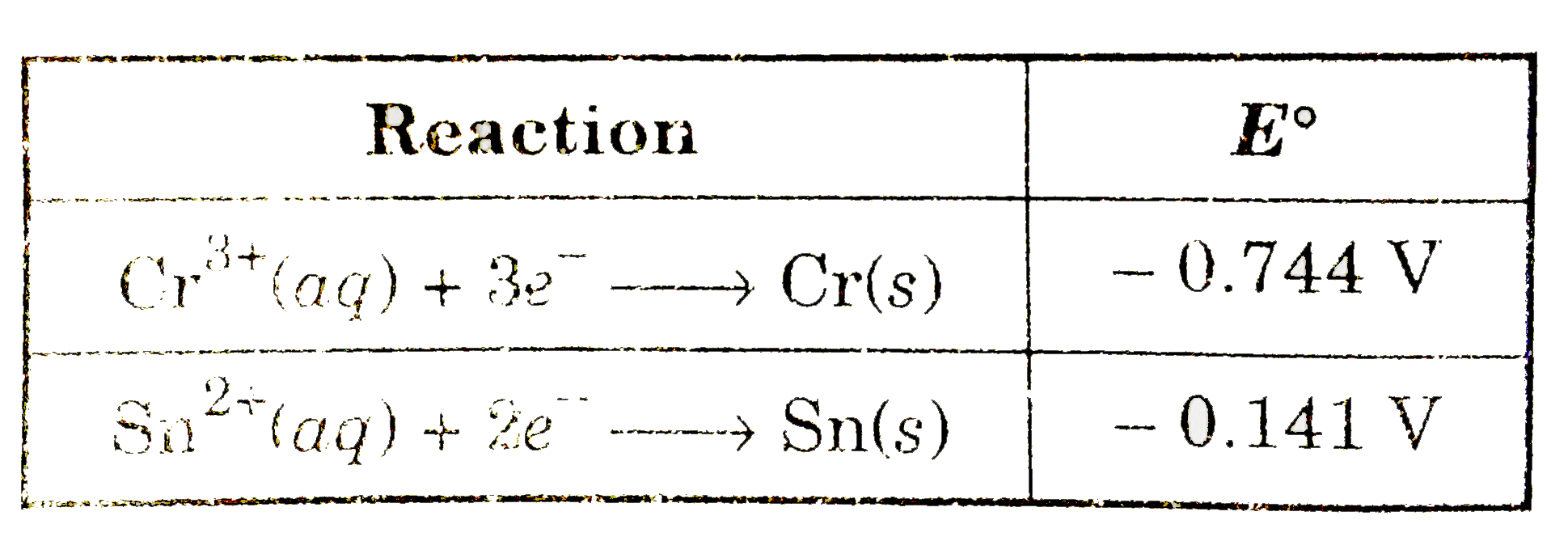Given these standard reduction potentials, what is the standard reduction potential for
Co3+(aq)+3e−→Co(s)?
Co3+(aq)+e−→Co2+(aq)E∘=1.82V
Co2+(aq)+2e−→Co(s)E∘=−0.28V
2.10V
1.54v
1.26v
0.42V
The correct Answer is:D
Step by step video, text & image solution for Given these standard reduction potentials, what is the standard reduction potential for Co^(3+)(aq) + 3e^(-) rightarrow Co(s)? Co^(3+)(aq) + e^(-) rightarrow Co^(2+)(aq) E^(@) = 1.82V Co^(2+)(aq) + 2e^(-) rightarrow Co(s) E^(@) = -0.28V by Chemistry experts to help you in doubts & scoring excellent marks in Class 12 exams.
Updated on:21/07/2023Topper's Solved these Questions
- ELECTROCHEMISTYBOOK - GRB PUBLICATIONCHAPTER - ELECTROCHEMISTYEXERCISE - Batteries
10 Videos
- ELECTROCHEMISTYBOOK - GRB PUBLICATIONCHAPTER - ELECTROCHEMISTYEXERCISE - Thermodynamics in Electrochemistry
22 Videos
- ELECTROCHEMISTYBOOK - GRB PUBLICATIONCHAPTER - ELECTROCHEMISTYEXERCISE - Galvanic Cell and Salt Bridge
85 Videos
- D-BLOCK ELEMENTSBOOK - GRB PUBLICATIONCHAPTER - D-BLOCK ELEMENTSEXERCISE - Subjective Type
18 Videos
- ENVIRONMENTAL CHEMISTRY BOOK - GRB PUBLICATIONCHAPTER - ENVIRONMENTAL CHEMISTRY EXERCISE - Straight objective type
40 Videos
Similar Questions
According to the standard reduction potentials:
Pb2+(aq)+2e−→Pb(s) E∘=−0.13V
Fe2+(aq)+2e−→Fe(s) E∘=−0.44
Zn2+(aq)+2e−→Zn(s) E∘=−0.76V
Which species will reduce Mn3+ to Mn2+[E∘=1.51V but will NOT reduce Cr3+→Cr2+[E∘=−0.40V]
View SolutionUse the given standard reduction potentials to determine the reduction potential for this half-reactions.
MnO−4(aq)+3e−+4H+→MnO2(S)+2H2O(l)

View Solution
Knowledge Check
Given the standard reduction potentials, which statement is correct?
Cu2(aq)+2e−→Cu(s)E∘=0.34V2H+(aq)+2e−→H2(g)E∘=0.0VCr3+(aq)+2e−→Cr(s)E∘=−0.73VACr(s) will react with acid.BCu(s) will react with acid.CCu2+(aq) will react with acidDCu(s) will reacct with Cr3+(aq)Given these standards reduction potentials, what is the free energy change (in kJ. Mol^(-) for the reaction:
Pb(s)+2Ag+(aq)→Pb2+(aq)+2Ag(s)
Ag+(aq)+e−→Ag(s) E∘=0.80V
Pb2+(aq)+2e−→Pb(s) E∘=−0.13VA-180B-90C90D180Given the two standard reduction potentials below, what is the Ksp of Ag2CrO4 at 25∘C?
Ag2CrO4(s)+2e−→2Ag(s)+CrO2−4(aq) E∘=+0.446V
Ag+(aq)+e−→Ag(s) E∘=+0.799VA8.64×1011B1.08×10−6C1.08×10−12D1.11×10−39
Which of the half reactions, when coupled, will make a galvanic cell that will produce the largest voltage under standard conditons?
P. Cu2+(aq)+2e−→Cu(s) E∘=+0.34V
Q. Pb2+(aq)+2e−→Pb(s) E∘=−0.13V
R. Ag+(aq)+3e−→Al(s) E∘=−1.66V
View Solution
Use the standard reduction potentials to find the standard cell potential E∘, for the reaction:
Zn(s)+2Tl+(aq)→Zn2+(aq)+2Tl(s)
View SolutionWhat is the standard cell potential for the reaction,
2Cr(s)+3Sn2+(aq)→3Sn(s)+2Cr3+(aq)
given the E∘ values shown?

View SolutionUse the standard reduction potentials:
Sn2+(aq)+2e−→Sn(s) E∘=−0.141V
Ag+(aq)+e−→Ag(s) E∘=0.800V
To calcultate E∘ for the reaction:
Sn(s)+2Ag+(aq)→Sn2+(aq)+2Ag(s)
View SolutionUse the standard reduction potentials to determine what is observed at the cathode during the electrolysis of a 1.0 M solution of KBr that contains phenolphthalein.
O2(g)+4H+(aq)+4e−→2H2O(l) E∘=1.23V
Br2(l)+2e−→2Br−(aq) E∘=1.07V
2H2O(l)+2e−→H2(g)+2OH− E∘0=−0.80V
K+(aq)+e−→K(s) E∘=−2.92V
View Solution
